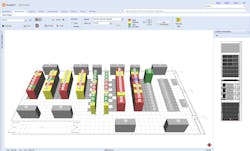In this week’s Voices of the Industry, Herman Chan, President of Sunbird Software, explores challenges of edge data center deployments, the data and capabilities you need to effectively manage these data centers, and why DCIM software is a critical enabler for achieving success at the edge.
Herman Chan, President of Sunbird Software
Latency has long been an enemy of data center managers. Yet, it’s only come to the forefront as a critical concern alongside downtime and operational costs in recent years—thanks to big data, the Industrial Internet of Things (IIoT), cloud and streaming services, and other technology trends placing resource burdens on data centers.
At the same time, end users and devices need anywhere, anytime access to the applications, services, and data housed in today’s data centers. A little lag may seem like a minor annoyance when streaming your favorite Netflix show, but imagine the damage that self-driving cars could cause without real-time GPS and positional data.
Latency is no longer tolerable for any use case—but especially for mission-critical functions. As a result, more organizations are seeking high-performance, cost-effective ways to provide customers with core content and functionality.
Enter the Edge Data Center
Edge data centers are small-to-mid-sized versions of their enterprise cousins but have all the same components of a traditional data center. They are placed closer to the local areas they serve (typically “Tier-2” locations) and thus are managed remotely as part of a complex deployment involving multiple edge data center sites. Despite being smaller, remote, and part of a larger deployment, edge data centers are being used the same way as larger data centers and thus are just as mission critical as their traditional counterparts.
How do you manage multiple small, mission-critical data centers to ensure availability and uptime when no one’s on site? Start by understanding the challenges of edge data center management, and then ensuring that you have the right combination of remote management capabilities and data center business intelligence to tackle them.
[clickToTweet tweet=”Herman Chan – Start by understanding the challenges of edge data center management. ” quote=”Herman Chan – Start by understanding the challenges of edge data center management. “]
Common Edge Data Center Management Challenges and Solutions
Although your edge data center management challenges may vary based on your deployment, the following are some of the most common and can be addressed with data-driven, remote visibility and control:
- Making the most of physical space and power capacity. Since edge data centers have a much smaller footprint than most enterprise data centers, optimizing capacity is critical. When managing space remotely, color-coded floor map reports displaying cabinet weight, percentage full, budgeted and actual power, and other metrics can help you determine the best places to install assets at a glance. Similarly, what-if analysis can help you understand the future impact of not only additions but also decommissions on your data center. Armed with this information, you can identify stranded space and power capacity and determine if you need to deploy additional resources to meet demand, or if you can defer capital expenditures.
- Directing technicians to complete changes properly. When you’re remotely managing multiple data centers, directing technicians on where to go and what to change can be a frustrating exercise. How can you tell them where to go and ensure that changes are made accurately when you don’t know where your assets are? Use 3D floor map visualizations of each of your edge data centers to get a baseline of where your cabinets are situated. Cabinet elevation views then can provide the exact U-position of your asset. Device views allow you to show technicians where data and power ports are located on devices to ensure that installers make connections correctly.
- Monitoring data center health across multiple locations. Monitoring data center health can be difficult when you’re responsible for multiple edge sites with their own power and cooling systems. To address this challenge, you need both a holistic view—such as an enterprise dashboard showing real-time power and environmental health and events for all data centers on a single screen—and more granular, cabinet-level metrics. This information provides advanced warnings of issues that can reduce uptime, such as hot spot formation, power capacity limitations, and loss of redundancy. Some remote management tools support power actions like switching devices on or off and power cycling them—critical capabilities when there’s no technician on site to reboot servers and quickly restore service.
- Managing all assets and their connections across the entire data center deployment. Most organizations leveraging edge data centers will have complex deployments involving multiple sites and business applications. Maintaining an accurate inventory of all your assets across these sites requires real-time views of cabinet contents, like servers, networking equipment, PDUs, and patch panels, as well as infrastructure devices and structured cabling. Track metrics like asset count by application, hosts per application, and asset cost by location to understand which applications require the most resources and how you can improve performance while decreasing costs. Understanding how assets are physically connected through visual circuit traces enables you to avoid overloaded circuits, decrease latency, and when combined with good cable management practices, quickly troubleshoot connections to reduce downtime.
- Ensuring physical security. Restricting physical access to edge data centers can be difficult when managed remotely. Use reporting, audit logs, and surveillance feeds to monitor who has access to different areas and cabinets in your data center, how often these areas are accessed, and if the access attempts result in success or failure. This data can help you reduce risk by keeping track of who has access to your edge data centers and would be critical to forensic analysis following a breach.
Simplify Edge Data Center Management with DCIM Software
The challenges of managing edge data centers exacerbate the need to leverage data with remote management. Unfortunately, the combination of remote management tools and analytic capabilities often requires multiple applications and databases. Using numerous spreadsheets and Visio diagrams and switching between an analytics platform and external ticketing system can easily lead to inaccurate data, incomplete or incorrect work orders, and error-prone decision making.
[clickToTweet tweet=”Herman Chan – Challenges of managing edge data centers exacerbate the need to leverage data with remote management. ” quote=”Herman Chan – Challenges of managing edge data centers exacerbate the need to leverage data with remote management. “]
That’s where Data Center Infrastructure Management can make the difference. A comprehensive DCIM software solution provides data center managers with a central system where they can view the assets, power, connectivity, cooling, and physical security across different sites and immediately make changes to their data centers—wherever they are located.
For example: Your what-if analysis reveals that you need to install new servers for an upcoming project. Within DCIM software, you can create a work order for this request, push it to your external ticketing service, and track it through completion. You can search for the best place to install the equipment based on space, power, cooling, and network capacity data, and then leverage 3D data center floor map visualizations and cabinet elevation views to direct the technician, without the need to physically be on site. Additionally, within the software, you can restrict the technician’s access to just the specified cabinet or containment area via RFID card authentication for an additional layer of security.
Edge data centers are cost-effective options that are just as mission critical as their traditional enterprise counterparts but have their own set of management challenges. Leveraging the remote management and business intelligence capabilities found in DCIM software can help you reduce latency, maintain availability and uptime, and ultimately achieve optimal performance while decreasing costs.
Herman Chan is President of Sunbird Software.
Sunbird Software is changing the way data centers are managed through radically simplified DCIM software. Want to make the most of your data center capacity? Download Sunbird’s webinar Data Center KPIs to Optimize Capacity Utilization, for insights from 451 Research’s Research Director of Datacenters & Critical Infrastructure, Rhonda Ascierto, and other data center industry experts.


